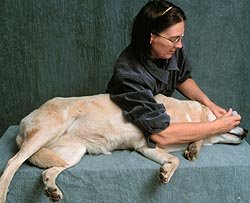Eye: Antibitoic Eye Drops for Dogs
Dog Ear QuickLinks
Canine Eye Infections:
Dog eye infections are conditions caused by bacteria, viruses or fungal species, which cause inflammation and viscous dog eye discharge. This discharge can contain pus and mucous . Bacteria is the primary cause of canine eye infections, which either cause eye infection in dogs as a primary condition or as a secondary complication of viruses, fungus, allergies or other non infectious problems.
Typical signs of canine eye infection include irritation, swelling, redness and mucopurulent discharge from the eyes. In chronic cases the condition may turn into a general systemic infection, therefore additional signs such as fever and generalized weakness and illness may accompany the infection.
In most cases, a clinical examination and taking a dogs history can reveal the cause and possible outcome of the condition in most cases. Laboratory procedures such as tear tests, the isolation and culturing of the bacterial population found in dog eye discharge and a detailed ophthalmic examination might be required for diagnosing the exact and/or underlying dog eye problem.
Treatment of canine eye infections is done specifically with antibiotics. These antibiotics are specially formulated for eye infections, in the form of canine anitibiotic eye drops or ointments. Dog eye drops that contain antibiotics are specific therapeutic preparations used for treating eye infections primarily.
When To use Antibiotic Eye Drops:
Canine eye drops are used to not only treat primary or secondary eye infections caused by bacteria, viruses and fungus (few species), but they can also act as a drying agent in cases where there is extra moisture/tears by eyes. Thus, canine eye drops are prescribed for common eye infections such as conjunctivitis, blepharitis, Dacryocistitis and inner dog eye infections.
For primary and/or common eye infections on the surface of the eye and around the eyes, this condition can be treated with only canine antibiotic eye drops or treated with ointments and supportive measures. Those infections that occur in the inner parts of the eye and those that are secondary complications may require an additional drug, surgery and a generalized treatment approach along with the use of these dog eye drops. Thus, the definite diagnosis of any dog eye problem is always completed prior to the initiation of any form of canine eye treatment.
Antibiotics used in Canine Eye Drops:
Multi-generic antibiotic groups are being used in available canine antibiotic eye drops. These are either administered individually or in combination with other antibiotics, according to the status and nature of the infection. Neomycin, Erythromycin, Bacitracin, Polymyxin, Tetracycline and Tobramycin are considered the most common and effective antibiotics widely used in treating canine eye infections. The combination of Neomycin, Bacitracin and Polymyxin (B) is commonly used for complicated and diffused cases of eye problems and is termed as a “Triple Antibiotic Preparation”.
Canine antibiotic eye drops are usually safe to use, but require proper dosage and administration instructions. Any of the aforementioned antibiotic drops usually heals a dog eye condition in 3 – 5 days. Canine eye conditions usually improve in 36 – 48 hours, but if unusual symptoms are noticed or the condition becomes worse, a veterinarian should be consulted immediately.
Administering Drops:
Medicating dog eyes can be tricky, since a dog under stress may move more than normal. One approach is to place a dog on a table. Standing on the side opposite of the eye, place the right arm over the shoulders. Take your other hand to push the muzzle to the table. Pull the dog eyelid down with the left hand and apply the dog eye drops with the right hand.

Administering Eye Drops
If the dog is difficult to restrain, try laying the dog on the side. Using the right arm and the upper body, constrain the dog. Use your right hand to hold the dog eye drops or eye ointment. With the left hand, hold the dogs head on the table and pull the dog eyelid down.
Additional Support:
Formulated canine antibiotic eye drops usually contain
antibiotics and
an aqueous (liquid) medium only, which is a requirement of this
specific
pharmacological preparation. However, supportive measures such as
offering
your dog treats and dog eye health supplements after the administration
of dog eye
medication and the use of supportive remedies for overall visual health
and
cleaning purposes along with antibiotics can help to achieve a timely
recovery.
Also, these available dog eye drops without a prescription,
supplements and remedies can help to improve the dogs immune
system and
general physiological functioning of the patient. Two homeopathic
natural dog eye products to consider
include Eye
Heal Drops for overall eye health and i-Clenz
to safely clean the areas around dog eyes.
|
|
